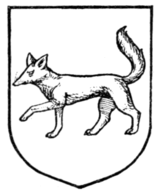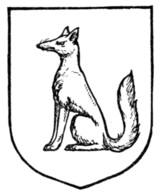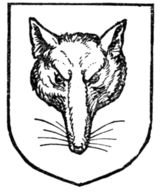"Struan" Robertson, and in the coats used by all other members of the Robertson Clan having or claiming descent from, or relationship with, the house of Struan. The wolf's head also appears in the arms of Skeen. Woodward states that the wolf is the most common of all heraldic animals in Spanish heraldry, where it is frequently represented as ravissant, i.e. carrying the body of a lamb in its mouth or across its back.
Much akin to the wolf is the Lynx; in fact the heraldic representation of the two animals is not
greatly different. The lynx does not often occur in heraldry except as a supporter, but it will be found as the crest of the family of Lynch. The lynx is nearly always depicted and blazoned "coward," i.e. with its tail between its legs (Fig. 342). Another instance of this particular animal is found in the crest of Comber.
A Fox (Figs. 343 and 344) which from the similarity of its representation is often confused with a wolf, is said by Woodward to be very seldom met with in British heraldry. This is hardly a correct statement, inasmuch as countless instances can be produced in which a fox figures as a charge, a crest, or a supporter. The fox is found on the arms and as the crest, and two are the supporters of Lord Ilchester, and instances of its appearance will be found amongst others in the arms






